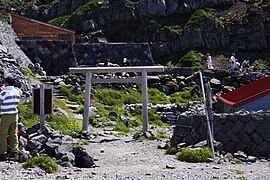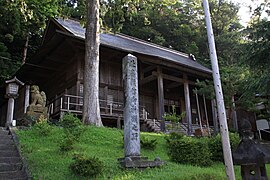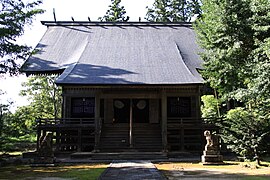Chōkaisan Ōmonoimi Shrine
You can help expand this article with text translated from the corresponding article in Japanese. (December 2023) Click [show] for important translation instructions.
| |
Chōkaisan Ōmonoimi Shrine (
The shrine is primarily dedicated to
The shrine directly worships the mountain as a
The shrine is the Dewa Province Ichinomiya, or the first ranked shrine of the Dewa Province.[5][13][14] It is close to the Three Mountains of Dewa which are also prominent spots of Mountain Worship.[13]
It is similar to Fujisan Hongū Sengen Taisha at Mount Fuji
History
The mountain has been worshipped since ancient times,
Traditions vary about the founding of the main shrine with some saying during it was founded during the reign of Emperor Keikō and others saying it was founded during the reign of Emperor Kinmei.[5] The repeated destruction of the main shrine means archaeological evidence is difficult to find.
However the two shrines at the foot of the mountain are known to have been founded in 564 in the reign of Emperor Kinmei.[7]
Early mentions of the shrine include the
In history every time the volcano erupted, the
The shrine has been a prominent place of shugendo since the Middle Ages.[5][18] A medieval buddhist myth of the temple says it was founded by the Buddhist monk En no Gyōja for "Chokai Daigongen".[19] This myth is most associated with Warabioka. Other myths involve other Buddhist monks like Ennin or Kūkai.
The shrine was subject to a legal battle after World War II because people were confused about who owned the summit with the end of State Shinto, as of 1966 the battle was still ongoing.[20] In 2008, the area from the summit to Kuchinomiya became a National Historic Site.[5]
Festivals
The shrine has a festival every year on July 14 called Hi-awase shinji (火合せ神事). During the festival all across
Sanchō-Gohonsha
| Sanchō-Gohonsha | |
|---|---|
山頂御本社 | |
Omonoimi no Kami | |
| Location | |
| Geographic coordinates | 39°5′51.43″N 140°2′55.21″E / 39.0976194°N 140.0486694°E |
Sanchō-Gohonsha is the main shrine and it is located on the peak of
Gallery
-
Very distant photo demonstrating the scale of the mountain
-
Birds eye view of the shrine complex
-
Torii
-
Torii from behind
-
Approaching the Honden
-
Mountain-top Main Shrine Honden
Fukura-kuchinomiya
| Fukura-kuchinomiya | |
|---|---|
吹浦口之宮 | |
 Fukura-kuchinomiya | |
| Religion | |
| Affiliation | Shinto |
| Deity | Tsukuyomi-no-Mikoto |
| Location | |
| Geographic coordinates | 39°04′30.45″N 139°52′44.05″E / 39.0751250°N 139.8789028°E |
Fukura-kuchinomiya is a subshrine located at the foot of the mountain.[6] It is located 15 km west of the main shrine and 10 km northwest of Warabioka-kuchinomiya
Local tradition says the shrine was founded by Ennin
The Honden is located on a hill and faces south.[7]
Tsukuyomi-no-Mikoto is enshrined here.
A lake called Maruikesama is worshipped nearby as a Kannabi. The lake is considered to be a Kami itself rather than merely one living in it.[b][23]
Gallery
-
Entrance Torii
-
Haiden
-
Honden
-
Honden from different angle
Warabioka-kuchinomiya
| Warabioka-kuchinomiya | |
|---|---|
蕨岡口之宮 | |
Toyoukebime ,Ukanomitama | |
| Location | |
| Geographic coordinates | 38°59′49.00″N 139°56′38.00″E / 38.9969444°N 139.9438889°E |
Warabioka-kuchinomiya is a subshrine located at the foot of the mountain.
It is said in local tradition that the legendary Buddhist monk En no Gyōja founded the shrine.[19]
The shrine has four small Hokora or subshrines of its own.[7]
There is a festival celebrated here on May 3 called Daimonbei Matsuri.[5]
There are three torii gates and the movie Rurouni Kenshin: The Legend Ends was filmed there.[24]
Gallery
-
First Torii
-
Second Torii
-
Third Torii
-
Honden
See also
- Fujisan Hongū Sengen Taisha
- Chōkai gassan ryōsho-gu
- Three Mountains of Dewa
- Mount Gassan with Gassan Shrine
- Mount Haguro with Hagurosan Shrine
- Mount Yudono with Yudonosan Shrine
- Other highly ranked shrines of Dewa Province
- Ninomiya Kinowa Shrine
- Sannomiya Omoimi Shrine
Notelist
- ^ Ōmonoimi-no-kami is believed to be the god of Mount Chōkai, or the northernmost post of the land of Yamato.
- ^ Lake coordinates: 39°4′22″N 139°53′30″E / 39.07278°N 139.89167°E
References
- ^ ISBN 978-0-8248-4785-2.
- ISBN 978-0-87011-620-9.
- ^ "Climbing a less-crowded mountain in Japan". Stripes Okinawa. 2017-11-20. Retrieved 2023-10-26.
- ^ Engi-shiki; Procedures of the Engi Era: Books I-V. Sophia University. 1970.
- ^ a b c d e f g h i j k l m "chokaizan omonoimi shrine(warabioka kuchi no miya) - shrine-heritager". shrineheritager.com. Archived from the original on 2023-11-11. Retrieved 2023-04-25.
{{cite web}}: CS1 maint: unfit URL (link) - ^ a b c d "Chokaizan Omono-Imi Jinja - Must-See, Access, Hours & Price". GOOD LUCK TRIP. 6 June 2022. Retrieved 2023-04-25.
- ^ a b c d e f g h "Okunomichi". 28 August 2014. Archived from the original on 2014-10-14. Retrieved 2023-11-04.
- ^ ISBN 978-0-8248-4785-2.
- OCLC 42978057.
- ^ "Enshrined Gods". kawawajinja.com. Retrieved 2023-06-18.
- ISBN 978-0-8248-3775-4.
- ^ "Keeping Ancient Mountain Worship Alive at Saitama's Kanasana Shrine". nippon.com. 2018-07-08. Retrieved 2023-10-18.
- ^ a b Suzuki, Masataka. "Dewasanzan Shinkō". Kokugakuin University Encyclopedia of Shinto.
- ^ "Nationwide List of Ichinomiya" (PDF). Archived from the original (PDF) on 2012-02-13. Retrieved 2023-12-01.
- ^ "Basic Terms of Shinto: Shinkai". www2.kokugakuin.ac.jp. Retrieved 2023-11-11.
- ISBN 978-90-04-22917-4.
- ISBN 978-90-04-19601-8.
- ISBN 978-1-350-17939-4.
- ^ a b "Chokai - Christopher E. Brennen". brennen.caltech.edu. Retrieved 2023-11-11.
- JSTOR 30232985.
- ^ Mogi, Sakae. "Hi-awase shinji". Kokugakuin University Encyclopedia of Shinto. Archived from the original on 2023-04-25. Retrieved 2023-04-25.
- ^ https://archive.today/NeCVF
- ^ "Maruikesama" (PDF). Archived from the original (PDF) on 2022-05-02. Retrieved 2023-11-04.
- ^ "Warabioka Kuchinomiya Shrine". Guidoor. Retrieved 2023-04-25.














